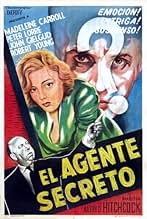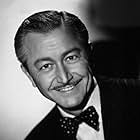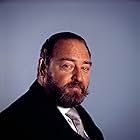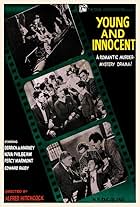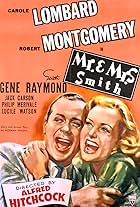IMDb RATING
6.4/10
9.2K
YOUR RATING
After three British Agents are assigned to assassinate a mysterious German spy during World War I, two of them become ambivalent when their duty to the mission conflicts with their conscienc... Read allAfter three British Agents are assigned to assassinate a mysterious German spy during World War I, two of them become ambivalent when their duty to the mission conflicts with their consciences.After three British Agents are assigned to assassinate a mysterious German spy during World War I, two of them become ambivalent when their duty to the mission conflicts with their consciences.
- Awards
- 1 win
Denys Blakelock
- Minor Role
- (uncredited)
Sebastian Cabot
- Bit Part
- (uncredited)
Tom Helmore
- Col. Anderson
- (uncredited)
Andreas Malandrinos
- Manager
- (uncredited)
Howard Marion-Crawford
- Karl
- (uncredited)
Michael Redgrave
- Army Officer
- (uncredited)
Michael Rennie
- Army Captain
- (uncredited)
Michel Saint-Denis
- Coachman
- (uncredited)
Storyline
Did you know
- TriviaSir Alfred Hitchcock convinced Sir John Gielgud to play the lead by describing the hero as a modern-day Hamlet. Gielgud, however, ended up hating that his character was an enigma.
- GoofsAlthough the film is set in 1916, fashion, hairstyles and set decoration are contemporary to 1936.
- Quotes
Mrs. Caypor: Do you understand German, Mr. Marvin?
Robert Marvin: Not a word -- but I speak it fluently.
- ConnectionsFeatured in Alfred Hitchcock: More Than Just a Profile (2005)
Featured review
A young British army officer is 'killed off' on the Western Front so that he can assume a false identity and go to Switzerland on a secret mission. Brody (or Ashenden, as he is now known) finds the dirty business of espionage distasteful, but is determined to see his mission through to a successful conclusion.
In this early Hitchcock thriller, John Gielgud plays Ashenden as a cheerless snob. His acting is wooden and unappealing, and his embraces with Elsa (Madeleine Carroll)are cold and unconvincing. Peter Lorre is an over-the-top delight as 'the General', the exotic and nasty little assassin. His toilet-paper tantrum is great fun, and he moves the plot along with superb little nuances of gesture (as when he follows the progress of the chocolate-box note).
There are some striking Hitchcockian moments. Is that the Master himself, coming down the ship's gangway ahead of Ashenden? The dead organist is 'playing' a constant discord alone in the Langenkirche, because his lifeless head is slumped on the organ keys. In a classic piece of tension-building, Hitchcock makes the organ sound swell dramatically as Ashenden and the General, unsuspecting, approach the body. Of course the corpse shouldn't be able to increase the organ's volume. That doesn't matter. The effect is great.
The scene shifts from London in an air raid to the Swiss Alps (and as a postscript, to the Bulgarian-Greek border). The main locations are attractively depicted, London's sky a lattice of searchlights, and Switzerland a mountain idyll.
Hitchcock plays clever tricks with the button found in the dead man's hand. It sets our heroes off in pursuit of Caypor, and then it comes back to haunt Elsa's conscience. When the folk singers swirl coins in bowls, Elsa can see only the infernal button. It does not bother the viewer that the coincidences surrounding the button are far-fetched, because the pace and confidence of the story-telling suppresses any incipient scepticism.
The incident on the Langen Alp is in many ways the film's climax, with Hitchcock's trademark suspense-building very much to the fore. As the much-dreaded moment draws near, the cuts to the polite German conversation class raise the viewer's anxiety to an unbearable pitch. Caypor's frantic dog is a masterly touch: the women and the pet know intuitively that the worst has happened. Soon afterwards, Elsa sits silent in her misery between Ashenden and the General, who both chat blithely across her. The camera closes in on her, explaining her feelings of guilt better than any dialogue could.
Throughout his long career, Hitchcock pursued a specific ideal of feminine beauty. Kim Novak and Tippi Hedren were its 1960's manifestation, and here in 1936 Madeleine Carroll is the fresh-faced girl with the fine bone structure and the blonde bob.
The arbitrary deaths in the final reel are silly, and the crash of the model train even sillier, but by this stage the director has eschewed exposition and is hurrying to tie up the plot's loose ends. Even if the viewer thinks hard, he is at a loss to explain what Ashenden was ever doing in Switzerland in the first place: but the trick is not to think too hard.
In this early Hitchcock thriller, John Gielgud plays Ashenden as a cheerless snob. His acting is wooden and unappealing, and his embraces with Elsa (Madeleine Carroll)are cold and unconvincing. Peter Lorre is an over-the-top delight as 'the General', the exotic and nasty little assassin. His toilet-paper tantrum is great fun, and he moves the plot along with superb little nuances of gesture (as when he follows the progress of the chocolate-box note).
There are some striking Hitchcockian moments. Is that the Master himself, coming down the ship's gangway ahead of Ashenden? The dead organist is 'playing' a constant discord alone in the Langenkirche, because his lifeless head is slumped on the organ keys. In a classic piece of tension-building, Hitchcock makes the organ sound swell dramatically as Ashenden and the General, unsuspecting, approach the body. Of course the corpse shouldn't be able to increase the organ's volume. That doesn't matter. The effect is great.
The scene shifts from London in an air raid to the Swiss Alps (and as a postscript, to the Bulgarian-Greek border). The main locations are attractively depicted, London's sky a lattice of searchlights, and Switzerland a mountain idyll.
Hitchcock plays clever tricks with the button found in the dead man's hand. It sets our heroes off in pursuit of Caypor, and then it comes back to haunt Elsa's conscience. When the folk singers swirl coins in bowls, Elsa can see only the infernal button. It does not bother the viewer that the coincidences surrounding the button are far-fetched, because the pace and confidence of the story-telling suppresses any incipient scepticism.
The incident on the Langen Alp is in many ways the film's climax, with Hitchcock's trademark suspense-building very much to the fore. As the much-dreaded moment draws near, the cuts to the polite German conversation class raise the viewer's anxiety to an unbearable pitch. Caypor's frantic dog is a masterly touch: the women and the pet know intuitively that the worst has happened. Soon afterwards, Elsa sits silent in her misery between Ashenden and the General, who both chat blithely across her. The camera closes in on her, explaining her feelings of guilt better than any dialogue could.
Throughout his long career, Hitchcock pursued a specific ideal of feminine beauty. Kim Novak and Tippi Hedren were its 1960's manifestation, and here in 1936 Madeleine Carroll is the fresh-faced girl with the fine bone structure and the blonde bob.
The arbitrary deaths in the final reel are silly, and the crash of the model train even sillier, but by this stage the director has eschewed exposition and is hurrying to tie up the plot's loose ends. Even if the viewer thinks hard, he is at a loss to explain what Ashenden was ever doing in Switzerland in the first place: but the trick is not to think too hard.
Details
Box office
- Gross worldwide
- $605
- Runtime1 hour 26 minutes
- Color
- Aspect ratio
- 1.37 : 1
Contribute to this page
Suggest an edit or add missing content




